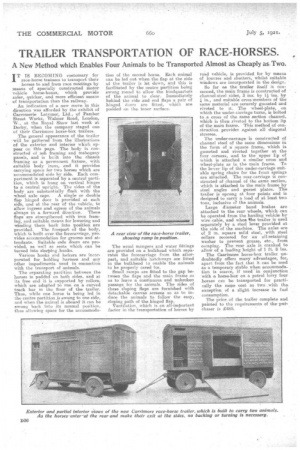TRAILER TRANSPORTATION OF RACE-HORSES.
Page 22

If you've noticed an error in this article please click here to report it so we can fix it.
A New Method which Enables Four Animals to be Transported Almost as Cheaply as Two.
I. T IS BECOMING customary for „ race-horse trainers to transport their horses to and from race meetings by means of specially constructed motor vehicle horse-boxes, whioh provide safer, quicker, and more efficient means of transportation than the railway.
An indication of a new move in this direction was afforded by the exhibit of Carrosserie Latymer, Ltd. of Pamber Street Works, Waliner Ec;ad, London, W., at the Royal Show last. week at Derby, when the company staged one of their Carrimore horse-Cox trailers.
The. general appearance of the trailer will be gathered from the illustrations of the exterior and interior which appear on this page. The body is constructed. of ash framing and mahogany panels, and is built into the chassis framing as a permanent fixture, with suitable body irons, and it provides carrying space for two horses which are accommodated side by side. Each compartment is separated by a central partition, which is hung on vertical hinges to a central upright. The sides, of the body are substantially flush with the wheel axle caps. A single or double flap a door is provided at each sidb, and at. the rear of the vehicle, to allow ingress and egress of the animals always in a forward direction, These flaps are strengthened with iron framing, and suitable means for lowering and winding them .back into position are provided. The forepart. of the body, which is built over the foreoarriage, provides accommodation for grooms and attendants. Suitable side doors are provided, as well as seatswhich can be turned into sleeping ,bunks.
Various hooks and lookers are incorporated for holding harness and any other impedimenta used in connection with the transport of animals.
The separating partition between the horses is paddbd on both sides, and at its free end it is supported by rollers, which are adapted to run on a curved track bar in the floor of the trailer. Thus, while one horse is being led in the centre partition is swung to one side, and when the animal is aboard it can be swung back into its normal position, thus allowing space for the accommoda
tion of the second horse. Each animal can be led out when the flap at the side of the trailer is let down, and this is facilitated by the centre partition being swung round to allow the hindquarters of the animal to clear. Immediately behind the side and end flaps a pair of hinged doers are fitted, which are padded on theinner surface.
The usual mangers and water fittings are provided on a bulkhead which separates the forecarriage from the afterpart, and suitable hatehways are fitted in the bulkhead to enable the animals to be properly cared. for.
Small ramps are fitted to the gap between the flaps and the main frame so as to leave a, continuous and unbroken passage for the animals. The sides of these sloping flaps are furnished with detachable canvas screens so as to induce the animals to follow the easy, sloping path of the hinged flap.
Ventilation, which is an all-important factor in the transportation of horses by road vehicle, is provided for by means of louvres and shutters, whilst suitable windows are incorporated in the design.
So far as the trailer itself is concerned, the main frame is constructed of channel-steel sides, 3 ins. by 14 ins, by in., and suitable cross-members of the same material are securely gusseted and riveted to it. The wheel-plate, on which the under-carriage turns, is bolted to a cross of the same section channel, which is then riveted to the bottom lip of the main frame.. This method of eonstriiction provides against all diagonal stresses.
The under-carriage is constructed of channel steel of the same dimensions in the form of a square frame, which is gusseted and riveted together at the four corners, and to the upper lip of
which is attached a, similar cross and wheel-plate as in the main frame. To the lower lip of this under-carriage suit,
able spring chairs for the front springs are attached. The rear-carriage is con structed of channel of the same section, which is attached to the main frame by steel angles and gusset plates. The trailer is sprung at four points and is designed to carry a load of at least two tons, inclusive of the animals.
Large diameter band brakes are attached to the rear wheels, which can be operated from the hauling vehicle by wire cable, and whea the trailer is used separately by a steel lever provided at the side of the machine. The axles are of 2 in. square mild steel, with steel rollers recessed for an oil-retaining washer to prevent grease, etc. from
escaping. The rear axle is cranked to allow of a loading height of 1 ft. 8 ins. The Caarimoxe horse-box trailer undoubtedly offers many advantages, for,
apart from the fact that it can be used
as a temporary stable when accommodation is scarce, if used in conjunction
with a home-box on a petrol lorry four horses can be transported for practically the same cost as two with the. exception of a slight increase in fuel consumption.
The price of the trailer complete and painted to the requirements of the putchaser is £465.
































